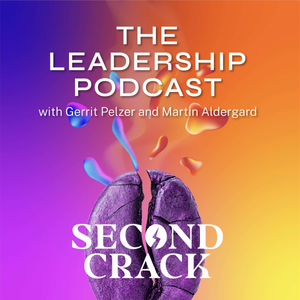
Second Crack — The Leadership Podcast
Gerrit Pelzer, Martin Aldergard
Leadership Consultant Martin Aldergard and Executive Coach Gerrit Pelzer explore everyday leadership dilemmas and paradoxes. Get ready for thought-provoking questions which invite self-reflection and help you grow as a leader. More info: https://secondcrackleadership.com

1 Listener
All episodes
Best episodes
Top 10 Second Crack — The Leadership Podcast Episodes
Goodpods has curated a list of the 10 best Second Crack — The Leadership Podcast episodes, ranked by the number of listens and likes each episode have garnered from our listeners. If you are listening to Second Crack — The Leadership Podcast for the first time, there's no better place to start than with one of these standout episodes. If you are a fan of the show, vote for your favorite Second Crack — The Leadership Podcast episode by adding your comments to the episode page.

360 Degree Feedback: A Welcome Punch in the Gut for Leaders
Second Crack — The Leadership Podcast
08/24/23 • 48 min
A 360 Degree Feedback may be the most powerful leadership development tool you will ever use — if you use it correctly.
Feedback holds the key to successful leadership development. Despite our well-intentioned endeavours, our actions may not always align with our intentions in the eyes of others. The most successful leaders understand how they are perceived by others and adjust their actions and manage perception accordingly.
Receiving candid feedback is not always pleasant, but it invariably provides you with an opportunity to improve and develop as a leader.
A 360 Degree Feedback is a multi-rater assessment that weaves together insights from diverse vantage points. These vantage points, ranging from superiors and peers to subordinates and self-assessment, converge to provide a well-rounded picture of how others see you in comparison to how you see yourself.
This powerful tool, however, often falls short of its potential due to oversight in key aspects. A successful 360 journey commences with meticulous pre-process preparation, continues with accurate result interpretation, and ultimately requires taking the right actions to help you grow as a leader and create the desired impact.
Before Embarking on the 360 Degree Feedback Journey:
- Define Your Purpose: Articulate why you are pursuing the 360 Degree Feedback and be clear on the context.
- Curate Your Raters: Enlist a diverse and representative array of raters, not just your best friends.
- Personal Invitations: Extend personalised invitations to your raters, and encourage them to provide ample text answers rather than mere ratings.
Receiving Your 360 Degree Feedback Results:
- Guided Interpretation: Ensure you have a debriefing session with an executive coach certified in the 360 Degree Feedback tool you are using. A professional coach can help you navigate through a complex report and put things into perspective, enabling you to interpret the results correctly and gain the most from your 360 for effective leadership development.
- Attitude is Key: Embrace an open mindset and resist the instinct to be defensive when confronting critiques. Approach feedback as a snapshot of external perception at a particular point in time.
- Explore Alignment an Discrepancies: Explore hidden strengths recognised by others and blind spots wehre your self-assessment overshoots. Look for consistencies and inconsistencies in the ratings and comments. Scrutinise congruences and divergences within and between rater groups.
Take Effective Actions for Your Personal Growth:
- Seek More Feedback: Paradoxically, often the 360 Degree Feedback is only the start for receiving more feedback: engage with selected raters, sharing insights from your report. Seek further clarification and request specific suggestions for improvement.
- Holistic Growth: Development involves more than overcoming weaknesses. Capitalising on your strengths while bridging gaps is the pathway toward exceptional leadership.
- A Coach's Guiding Hand: Collaborating with an executive coach can truly propel your personal growth. For most people, changing behavioural patters and unproductive habits is more difficult and time-consuming than they think. Busy executives tend to focus on their projects and day-to-day work, often neglecting their own development. “A coach really, really helps”, as Eric Schmidt, former Google CEO, famously noted.
Get in touch with us:
web: secondcrackleadership.com
email: [email protected]

1 Listener
1 Comment
1
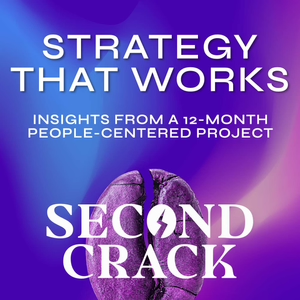
Strategy that Works: Insights from a 12-Month People-Centered Project
Second Crack — The Leadership Podcast
10/26/23 • 45 min
In this episode, we share insights from a 12-month project where we involved all executives, managers and employees in shaping and implementing a new vision and strategy for growth. The project resulted in re-energizing and motivating 700 people at a large chemical manufacturing plant, fostering not only business expansion but also fortifying a sense of ownership and teamwork across the site.
Key takeaways
- Approach vision and strategy as a process, implementation included
- Involve people in co-creating the vision & strategy to cultivate a sense of ownership and use the collective intelligence of the organisation
- While the process requires more time upfront, the investment pays off rapidly during the implementation phase
Key moments
01:28 - Introduction to the case
A brief overview of the case company and the overall approach to the project.
05:02 - Phase 1: Gathering input
We delve into how we engaged numerous individuals right from the project's inception, seeking their perspectives on the future direction. Our emphasis was on understanding people, their ideas, motivations, hopes, and concerns. Unlike conventional strategy planning, there was minimal focus on data collection and SWOT analysis in this phase.
08:43 - Phase 2: Shaping the initial vision and strategy
We discuss how, through guided conversations, we transformed initially diverse opinions into a shared vision and strategy by the end of the process. Our focus was on creating opportunities for dialogue, ensuring a shared context, and facilitating co-creation.
16:18 - Phase 3: Defining a clear and concise vision & strategy
We address the most challenging phase of the project: transitioning from 'brainstorming' to making decisive choices to arrive at a clear and concise strategy ready for implementation. We share the four pillars of the strategy that were developed, highlighting how it was laser-focused on making the growth vision a reality.
28:02 - Phase 4: Supporting implementation
We explore the structure we established to facilitate follow-up, learning, and adaptation during the project's implementation phase. This included monthly leadership workshops, individual executive coaching, and effective communication and involvement of all employees.
Reflection Questions
- What would I need to consider when designing my strategy process?
- For instance, how long time do I have? Who needs to be involved? What role does my leadership team play in the process? Who owns the process and how are decisions made? How can I engage managers and employees? What role will they assume? How prepared are managers and employees to be involved? How prepared am I and the leadership team for increased involvement in the strategy process?
- Based on this, how can I create the conditions that everybody can be involved? How do I make sure everyone's voice is heard?
- Additionally, how can I, as a leader of a local entity or unit within a larger organization, approach the strategy process differently? How can I drive a growth vision and strategy that doesn't necessarily have to originate from the headquarters?
More info about us and our work is also on our website: secondcrackleadership.com.
Do you have any questions, feedback, or suggestions for us? Would you like to explore how we can help you to drive results in your organisations through a company-wide initiative or individual executive coaching? Then email us at [email protected].
To connect with us on LinkedIn:
Martin Aldergård
Gerrit Pelzer

1 Listener
1 Comment
1
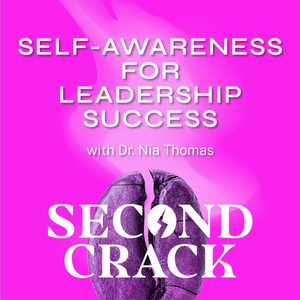
Self-Awareness for Leadership Success - with Dr. Nia Thomas
Second Crack — The Leadership Podcast
04/27/23 • 46 min
From our experience in executive coaching and leadership development we see again and again that self-awareness is absolutely mission critical for self-development and personal growth. And of course, we can ask the question: Is there a link between a leader's self-awareness and his or her leadership effectiveness?
To help us answer this question, we have a great guest on the show, Dr. Nia Thomas.
Key moments
[05:19] Nia shares what triggered her curiosity about leadership and self-awareness
[08:04] Most important findings from Nia’s research. The “strategic level disconnect” between what people at the most senior levels of the organizations are setting in motion and what they seem to be thinking, compared to what others are thinking. One element of this is filtered feedback, and regardless of organisation, in a senior leadership position you will get filtered feedback, which means that you are disconnect to the rest of the organisation to a greater or lesser extent.
[16:14] Identified 3 layers of Leadership Self-awareness
- Reflection or Internal self-awareness, which is about me looking inward, knowing myself.
- Recognition or Internal social self-awareness, is about recognising that people are observing me and have opinions about me.
- Regulation or External social self-awareness, which is about regulating my behavior based on knowing myself, and knowing how others see me.
[27:40] Is there a correlation between a leader's self-awareness and their effectiveness?
The answer is a resounding yes - but. Leaders with high degree of self-awareness is an essential component to generate success. However, many organisations say it’s their aspiration, however the reality is, it’s not happening everywhere.
[31:28] What are potential dilemmas or challenges leaders might encounter when developing, or sharpening, their self-awareness?
- Need to recognise that self-awareness is an ongoing journey that you need to invest your time and effort
- The risk of filtered feedback, especially as a more senior leader
- Situations of stress, when we can’t cope to regulate our behavior
- ‘Busyness’ and seen to always be doing something, with no space for reflection
Self-awareness is a journey - “Know thyself, but ensure you keep reacquainting yourself”.
Reflection Questions:
- Stop and ask: Can I describe how I think others see me?
If I can't, how will I develop my antenna, my space, my opportunity to be able to answer that question? - What are the situations where I need to be more self-aware of my own behavior and its impact on my effectiveness as a leader?
- What do I need to focus on to increase my self-awareness?
- What are certain circumstances, situations, or people that either enhance or deplete my self-awareness?
---
Get in touch with Nia through LinkedIn Dr. Nia Thomas or email at [email protected]
---
More info about us and our work on our website: secondcrackleadership.com
Do you have any questions, feedback, or suggestions for us? Would you like to explore how we can help you to drive results in your organisations through a company-wide initiative or individual executive coaching? Then email us at [email protected] or connect on LinkedIn.
Gerrit Pelzer
Martin Aldergård

1 Listener
1 Comment
1
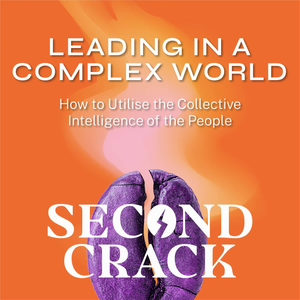
Leading in a Complex World Utilising the Collective Intelligence of the People
Second Crack — The Leadership Podcast
05/26/22 • 35 min
Today, leadership takes place in a challenging context, e.g.,
- increasing complexity
- increasing speed of change
- information overload
Thus, decision-making processes become more difficult. Leaders are at risk of either delaying decisions (gathering more information) or over-simplifying and rushing to decisions.
In an increasingly complex world, single leaders or small groups of leaders can’t have all the answers. Instead, they need to involve the whole team in sense-making and decision-making processes.
Involving more people may seem counterintuitive, as if it delayed decisions further. However, utilising the collective intelligence of the people leads to better decisions and gets buy-in from the start. (See also “How to Speed-Up Corporate Transformation”)
The need to be competent may also keep leaders from involving more people. They associate competence with having all the answers and giving people clear directions and instructions.
Of course, leaders need to have professional knowledge and business acumen. But they do not have to be the smartest person in the room. Today, the leader's role is less of an expert. Instead, leaders must surround themselves with the best talent, align them around a common goal, and create the conditions under which they can be their best.
Ron Heifetz says that leaders must distinguish technical problems from adaptive challenges. For technical problems solutions exist already. A leader or an expert has the answer and can tell people what to do. In contrast, an adaptive challenge is totally new. No experts have the answer yet.
“The leader's job is not to provide the answer, but instead to frame the right questions for which answers are developed and discovered by the collective intelligence of the people.”
Being competent in today’s context is less about knowledge but instead about qualities we have covered in previous episodes such as being humble, understanding that human beings are driven by emotions , and that trust-based relationships are the foundation for performance.
According to Daniel H. Pink, leaders need to turn from bosses who tell others what to do into autonomy supporters. This can be done using coaching skills, including listening and asking powerful questions.
What might keep leaders from utilising the collective intelligence of the people:
- The perceived need to express competence by having all the answers and tell others what to do; the fear that asking questions equals looking incompetent.
- Past successes, such as frequent promotions, may make leaders think they do know better, they are smarter than others.
- They don’t belief in their teams and struggle with letting go of control, or removing themselves from the centre of decision-making.
Reflection Questions for Leaders
- How comfortable am I not knowing?
- Do I feel I need to have all the answers? Or do I still appear competent when I ask questions and say, “I don't know”?
- Do I feel a need to demonstrate I am the smartest person in the room?
If yes: why? How can I let go of this? - How open am I to ways of working that are different from mine?
- Do I believe in the potential of the people I'm working with?
- What role do I want to take in this process as a leader? Am I going to be the expert, or am I going to be more like a coach, a facilitator, an enabler, or might I be an observer?
More info about us and our work is on our website https://secondcrackleadership.com.
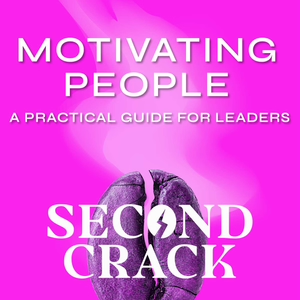
How to Motivate People: A Practical Guide for Leaders
Second Crack — The Leadership Podcast
12/21/23 • 44 min
Leaders often ask us, “How can I motivate my team?” or “How do I enhance employee engagement?”. Unfortunately, there is no simple answer, as motivation is a highly individual and complex subject.
But the challenge of motivating people is also what makes life interesting as a leader. Wouldn’t it be boring if we were all like robots, needing three pushes of a button, to be motivated?
Nevertheless, there are common motivational “themes”, or guidelines, that every leader can benefit from.
Key moments
[04:37] A common misconception is that people are motivated by money. While it's certainly true that people have jobs in order to earn money, once individuals feel fairly compensated, other aspects take precedence.
[09:36] Daniel H. Pink emphasises three fundamental drivers:
Autonomy is about freedom how to do the work, when to do the work, and, ideally, who with. While there are of course limits to autonomy at work, it is crucial for leaders to act as autonomy supporters.
[17:42] Mastery entails the joy of honing skills and receiving recognition for expertise. Viewing people development as an investment rather than an expense is a testament to organisational wisdom.
[23:26] Purpose extends beyond monetary gains. People yearn to contribute to something meaningful, transcending the singular pursuit of increasing shareholder value.
[25:52] In addition to “finding meaning”, the “Socio-Analytic Model of Values, Interests, and Motives” identifies two additional “master motives”:
Getting along: Humans have always lived in groups. Getting along with others has been critical for our survival as a species. Furthermore, “at a deep and often unconscious level, people need attention and approval.”
Getting ahead: At the same time, every group or social unit always has a hierarchy with an unequal distribution of power. Individual strive for status differs, but from an evolutionary perspective, a higher status allows better choices in many areas of life.
[30:04] Björn Ekenvall said, "You can't motivate people to perform. It's actually the other way around". Helping people to be successful, will generate motivation and ignite a self-reinforcing cycle of performance and motivation.
[31:15] As motivation is so highly individual, leaders need to understand the individuals they are working with: What excites them? What do they like to learn? What are their aspirations?
[34:04] Recognition and feedback signify a leader's care, fostering involvement and a sense of importance among team members.
[38:00] A leader's attitude directly impacts motivation and performance: Leaders who look at their people as heroes increase the chances they become heroes. Leaders who treat people like children might find they behave like children.
[41:30] Reflection Questions.
Reflection Questions
- Autonomy: How can I give people more freedom regarding how they work, when they work, and who they work with?
- Mastery: How can I nurture individuals’ development?
- Purpose: Does our company have a compelling purpose and vision that goes beyond profit-making?
- Personal Motivation: What motivates me as a leader? And how might this differ from others?
More info about us and our work is also on our website secondcrackleadership.com
Do you have any questions, feedback, or suggestions for us? Would you like to explore how we can help you to drive results in your organisations through a company-wide initiative or individual executive coaching? Then email us at [email protected].
To connect with us on LinkedIn:
Martin Aldergård
Gerrit Pelzer
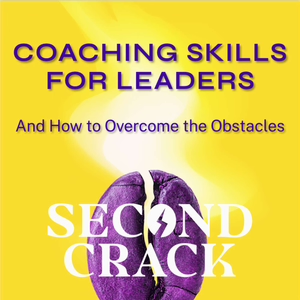
Coaching Skills for Leaders And How to Overcome the Obstacles
Second Crack — The Leadership Podcast
01/25/24 • 41 min
Applying coaching skills as a leader is one of the best ways to develop people and boost employee engagement. And in fact, many leaders have attended "coaching skills for leaders" or "manager as a coach" trainings. Why then, we might ask, is not everyone in every organisation fully engaged, yet. Is coaching not working, after all?
We are convinced coaching does work, but there are factors that keep leaders from applying them.
What is coaching?
Coaching should not be seen as a remedy to fix underperformance. Coaching is not about telling people hat to do. According to Sir Joh Whitmore, "Coaching is unlocking a person’s potential to maximise their own performance. It is helping them to learn rather than teaching them."
A simple recipe for applying coaching skills at work: tell less, listen more, ask powerful questions — and all this on a foundations of trust-based relationships.
Tell less: Leaders can’t have all the answers; instead, they need to utilise the collective intelligence of the people.
Listen more: Listening is more powerful than most people think. Who people feel listened to, they feel taken seriously as a person, and this in itself can boost motivation.
Ask powerful questions: Asking triggers thinking, taps into a person’s own intelligence and leverages potential. It can create buy-in and build self-leadership. Good questions are open and often start with "how" or "why." They encourage solution-focused thinking rather than analysing problems.
Trust: Coaching is not a mechanical process. The relationship between coach and coachee is as important as a the “technique”. Without trust, coaching won’t work. Seeing the other person full of potential removes the obstacles that keep them for utilising their potential.
Not every situation at work calls for coaching though. Coaching is for longer-term development, and also depends on a persons "readiness."
Leaders can apply coaching skills informally during 1:1 interactions or team meetings, or in a more formal coaching setting.
It is paramount for leaders to invest the time necessary for coaching to work. This can be challenging because while coaching is important, it rarely ever becomes urgent.
Lastly, there is no shortcut to mastery in using coaching skills for leaders. You can't become perfect without passing the beginner stage during which you need to live with making mistakes and learning from them.
Reflection Questions for Leaders:
- Suppose a miracle happened overnight, and all these obstacles that prevent you from using more coaching at work are removed. How will you start discovering that the miracle actually happened? And after that then, what will you be doing then that you are not doing now?
- On a scale of 1 to 10, how confident are you today that your team members are capable to deliver outstanding work? Now, suppose you fully believed that your team members are truly full of potential. How would you then interact differently with them?
- How satisfied are you with the proportion of time that you spend as a leader in the urgent but not important quadrant versus the not urgent but important quadrant?
More info about us and our work is also on our website secondcrackleadership.com
Do you have any questions, feedback, or suggestions for us? Would you like to explore how we can help you to drive results in your organisations through a company-wide initiative or individual executive coaching? Then email us at [email protected].
To connect with us on LinkedIn:
Martin Aldergård
Gerrit Pelzer

Can, Care, Do: How to Build Trust and Spark Action — with Jim Massey, CSO
Second Crack — The Leadership Podcast
05/25/23 • 43 min
We are joined by Jim Massey, Chief Sustainability Officer at Zai Lab, and former global Vice President of ESG at AstraZeneca. Jim shares his experience as a global sustainability leader, and how he is using the Can, Care, Do model to lead transformation in the healthcare industry. Jim is also the author of the newly launched book "Trust in Action".
Listen and gain insights on how you can build trust: the foundation of all positive action and change. And as always, we end with a few reflection questions for you.
Can, Care, Do is a simple and easy-to-remember guide that you can use to build trust and spark action. And Jim shares stories and practical examples of how he has used the approach to lead change in two organisations under very different circumstances. At AstraZeneca, Jim lead the transformation towards sustainability goals in a large multi-national organisation. At Zai Lab, it is all about scaling sustainability from the start, as the company is growing. In both cases, trust is a fundamental component, but different elements of trust need to be addressed.
Key moments
[05:10] Trust in Action. Trust and action run in parallel.
[09:30] The elements of the Can-Care-Do model and how to use it.
[15:31] How Jim put the Can-Care-Do model into practice, as the newly appointed, ‘outside’ leader, of a highly qualified team of ESG specialists.
[20:17] The biggest challenge? To hold myself accountable.
[26:12] Growing and scaling a global bio-tech start-up, being planet positive from the get-go.
[31:07] Stepping into the BS. Addressing the systems that are getting in the way of trust.
[36:57] From all the things that needs to change, scope out something, and focus on that little piece.
Reflection Questions:
- When reflecting, the most powerful actually sits in Can, as in why do I exist. For me as a leader, what is my why? Why am I here, and am I fulfilling that? Or am I distracted with so much of the Doing, that I’m forgetting my greatest impact?
- At work today, did I feel I could be myself, and were there perhaps situations where I felt I couldn’t? And reflecting on what to do about it: Is it about me to set the intension of behaving differently next time, or is it something ‘in the system’ that allows, or doesn’t allow, me to be my true self?
- As I face a challenging leadership situation, or not seeing the action or results that are needed, how can I use this situation as an opportunity to nurture and build trust? Which of Can, Care, or Do is the area I need to work on?
Information about Jim and his book ‘Trust in Action’
You can find more information about Jim and his book at www.jimmassey.co
Or on LinkedIn Jim Massey
-----
More info about us and our work is on our website secondcrackleadership.com
Do you have any questions, feedback, or suggestions for us? Would you like to explore how we can help you to drive results in your organisations through a company-wide initiative or individual executive coaching? Then email us at [email protected]
To connect on LinkedIn:
Gerrit Pelzer
Martin Aldergård

What Can Leaders Learn from Horses? With Ed Renshaw
Second Crack — The Leadership Podcast
09/26/24 • 40 min
Gerrit Pelzer and Martin Aldergård delve into an unexpected but insightful theme: what leaders can learn from horses. Joined by guest Ed Renshaw, an executive coach with expertise in equine-assisted leadership development, they explore the parallels between interacting with horses and leading people, providing a unique perspective on leadership dynamics.
Highlights:
Purposeful Leadership: Horses, like people, respond to clear, authentic leadership. Ed explains how horses mirror human energy and intentions, offering leaders immediate feedback on their behavior. Horses thrive under purposeful direction, and this mirrors what human teams expect from their leaders.
Horses as Mirrors: One of the central concepts discussed is how horses, being prey animals with a heightened fight-or-flight response, serve as perfect mirrors for human behavior. If a leader approaches a horse with too much anxiety or uncertainty, the horse will react similarly, providing an unfiltered reflection of how leaders might be perceived by their teams.
Non-Bias and Vulnerability: Horses don't care about a person's title or position—they only respond to how a person shows up in the moment. This non-judgmental nature strips away ego, requiring leaders to be truly present, vulnerable, and authentic—traits that are critical for fostering trust and followership in human leadership contexts as well.
Feedback and Self-Reflection: Working with horses brings up powerful insights quickly, potenitally much faster than traditional coaching or leadership development programs might. Ed shares real-life examples where leaders were humbled by the honest feedback provided by their equine counterparts, leading to profound realizations about their leadership style and impact.
Key Takeaways:
Instant Feedback on Leadership Style: Opposed to collecting feedback from humans, horses provide immediate, visceral responses. If a horse doesn't follow you, it might indicate that something is off with your leadership approach.
The Importance of Connection: Building a connection with a horse is similar to building human relationships at work. A leader must create trust, be aware of energy, and be able to shift between directive and supportive behaviors. This reflects a core challenge of leading people in today's complex work environments.
Overcoming Skepticism: While leaders may be skeptical about learning from horses, Ed shares examples that demonstrate how unconventional methods like equine-assisted leadership development can offer powerful, lasting lessons for corporate leaders.
Reflection Questions:
- How do I show up as a leader in critical moments? Am I purposeful and clear, or am I sending mixed signals to my team?
- What feedback do I receive from my team's body language or non-verbal responses, and how can I become more attuned to this?
- How can I create more opportunities for honest feedback in my leadership, even without access to a horse?
About Ed Renshaw
To learn more about Ed Renshaw and his work with equine-assisted leadership, connect with him on LinkedIn.
About Second Crack
More information about us and our work is available on our website: secondcrackleadership.com
For questions, feedback, or suggestions, or to explore how we can help you develop your leadership, email us at [email protected].
Connect with us on LinkedIn:
Martin Aldergård
Gerrit Pelzer
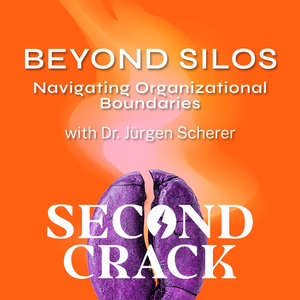
Beyond Silos: Navigating Organizational Boundaries, with Dr. Jürgen Scherer
Second Crack — The Leadership Podcast
03/21/24 • 50 min
In this episode, we explore how to navigate organisational boundaries. As enterprises expand, silos and barriers often emerge, hindering collaboration across units, functions, and regions. However, adept leaders understand that success comes from bridging such boundaries, both within and outside the organisation.
Join us as we delve into this vital leadership topic with our valued guest, Dr. Jürgen Scherer, a seasoned leader renowned for his expertise in navigating boundaries in global organisations.
Key Moments
Introduction to Dr. Jürgen Scherer [02:32]
Understanding why organizational Boundaries exist [04:34]
Navigation: A horizontal approach to overcoming silos and fostering connectivity [07:19]
Overcoming “friction by design” [11:08]
Real-Life Examples: Navigating internal boundaries in a pharmaceutical joint venture [22:24] and overcoming industry-wide external boundaries [29:02]
Summary Insights: The skills and traits of effective navigators [32:57]
Developing Navigation Skills: How organisations can cultivate more navigators [37:16]
Reflection Questions for Leaders [43:28]
- Reflect on a past project: How did you navigate challenges and boundaries, and what lessons have you learned?
- Overcoming friction by design: Where might well-intended department targets unintentionally hinder company-wide progress?
- What one action can you take today to navigate boundaries more effectively inside or outside the organisation?
- Who do you turn to in times of opportunity or crisis, and what qualities make them invaluable? How can you emulate their approach to enhance your own navigation skills?
----------------------------------
To connect with us on LinkedIn, click on our names here:
Jürgen Scherer
Gerrit Pelzer
Martin Aldergård
You can find Jürgen's consulting services on his website www.bxb-exchange.com. Additional info about Martin's and Gerrit's work is available on secondcrackleadership.com
Do you have any questions, feedback, or suggestions for us? Would you like to explore how we can help you to drive results in your organisations through a company-wide initiative or individual executive coaching? Then email us at [email protected]
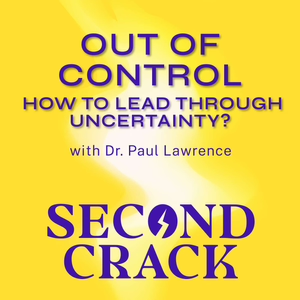
Out of Control — How to Lead Through Uncertainty? With Dr. Paul Lawrence
Second Crack — The Leadership Podcast
01/26/23 • 52 min
Leaders are expected to get results. In fact, some people will say that’s what leaders get paid for, and they are held accountable when the desired results are not achieved. But, at the same time, leaders can’t really control outcomes, especially during times that seem to become increasingly uncertain. So what can leaders do?
Dr. Paul Lawrence is helping us find answers in this episode. Paul is a leadership consultant, coach, researcher, and author of many books and articles on leadership and coaching.
Key Aspects and Statements
[05:12] Leaders often think there are things they control and others they can’t. What often gets forgotten is the bit in the middle: what we can influence. That’s the real domain of leadership in a complex world where you can’t control results.
[7:14] There are five ways of thinking about systems and about change.
[13:13 ] In the first three ways (linear and non-linear systemic, collaborative systemic), we imply that we are standing outside our organisation, we can diagnose things somehow, and then we'll work out what we need to do. We believe we can control things.
[15:42] In a complex system, however, a leader can't stand outside the organisation. They are part of the system. So, when I, as a leader, put something out there, other people will make sense of what I am saying in their own way. As a result, something quite unexpected may emerge; what the leader wanted and intended didn't happen. In other words, you don't get to control outcomes in a complex system.
What I can do as a leader is to get genuinely curious, get out into the organisation and explore what people are thinking and saying.
[28:14] In research about successful change in organisations, we found one word that stood out: dialogue. Dialogue is a way of engaging people in conversation. Dialogue requires leaders to get out there genuinely curious, to find out what people are saying, how they're thinking, how they're behaving. Leaders need to suspend judgment and be open to the possibility that what emerges from all those conversations might be different from what they expected.
[36:25] The way we think does change; it evolves through that social process of conversation and interaction. And that’s why it’s so important that we challenge how they think about systems and change.
Reflection Questions:
- How can I influence? How might influence happen in unexpected ways? and How can I be personally more at ease with my limitations of influence?
- How can I as a leader be more curious and open to learn from those I wish to influence, not from a point of control but from a point of influence - when it's about them, not about me?
- How do I think about change and how does that sharpen the way that I lead?
Dr. Paul Lawrence's contact details are on his website, and you can find all his books and articles here.
More info about us and our work is also on our website: secondcrackleadership.com.
Do you have any questions, feedback, or suggestions for us? Would you like to explore how we can help you to drive results in your organisations through a company-wide initiative or individual executive coaching? Then email us: hello at secondcrackleadership dot com.
To connect with us on LinkedIn:
Martin AldergårdGerrit Pelzer
Show more best episodes

Show more best episodes
Featured in these lists
FAQ
How many episodes does Second Crack — The Leadership Podcast have?
Second Crack — The Leadership Podcast currently has 45 episodes available.
What topics does Second Crack — The Leadership Podcast cover?
The podcast is about Leadership Coaching, Management, Leadership, Podcasts, Executive Coaching, Leadership Development, Business, Coaching and Change Management.
What is the most popular episode on Second Crack — The Leadership Podcast?
The episode title 'Self-Awareness for Leadership Success - with Dr. Nia Thomas' is the most popular.
What is the average episode length on Second Crack — The Leadership Podcast?
The average episode length on Second Crack — The Leadership Podcast is 42 minutes.
How often are episodes of Second Crack — The Leadership Podcast released?
Episodes of Second Crack — The Leadership Podcast are typically released every 28 days.
When was the first episode of Second Crack — The Leadership Podcast?
The first episode of Second Crack — The Leadership Podcast was released on Feb 12, 2022.
Show more FAQ

Show more FAQ
